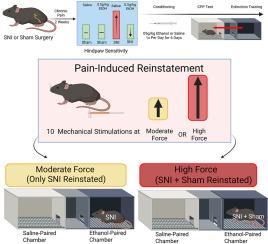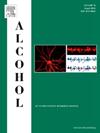慢性疼痛增加雄性小鼠对疼痛诱导的乙醇寻求恢复的敏感性。
IF 2.9
4区 医学
Q3 PHARMACOLOGY & PHARMACY
引用次数: 0
摘要
酒精使用障碍(AUD)和慢性疼痛是复杂和衰弱的条件,是高度合并症。超过50%的AUD患者有慢性疼痛。临床数据表明,患有慢性疼痛的人更有可能报告使用酒精来控制慢性疼痛,并且疼痛的程度与戒断一段时间后复发的可能性相关。这些数据导致假设疼痛可以驱动乙醇寻找和恢复慢性神经性疼痛的啮齿动物模型。采用条件位置偏好(CPP)模式对雄性C57BL6J神经损伤(SNI)小鼠的乙醇寻求模型进行了研究。小鼠接受了先前发现的能逆转疼痛行为的乙醇剂量(0.5g/kg)。有SNI和没有SNI的小鼠表现出相似的乙醇CPP大小和灭绝率。为了研究疼痛引起的与复发相关的行为,小鼠在返回CPP装置之前接受了“中等”或“高”强度的疼痛机械刺激后的恢复测试。“中度”疼痛的后爪刺激恢复了sni损伤小鼠的乙醇寻求行为,但假手术小鼠没有,而“高”强度刺激恢复了小鼠的乙醇寻求行为,无论损伤状态如何。这些数据表明,慢性疼痛的男性更容易在疼痛经历后恢复乙醇寻求。本文章由计算机程序翻译,如有差异,请以英文原文为准。

Chronic pain increases sensitivity to pain-induced reinstatement of ethanol seeking in male mice
Alcohol use disorder (AUD) and chronic pain are complex and debilitating conditions that are highly comorbid. Greater than 50 % of individuals with AUD have chronic pain. Clinical data suggest that people with chronic pain are more likely to report using alcohol to manage chronic pain, and that magnitude of pain is correlated with relapse probability after a period of abstinence. These data led to the hypothesis that pain can drive ethanol seeking and reinstatement in a rodent model of chronic neuropathic pain. A conditioned place preference (CPP) paradigm was used to model ethanol seeking in male C57BL6J mice with a spared nerve injury (SNI). Mice were conditioned with doses of ethanol previously found to reverse pain behavior (0.5 g/kg). Mice with and without SNI showed similar magnitudes of ethanol CPP and rates of extinction. To investigate pain-induced relapse-related behavior, mice underwent reinstatement testing following painful mechanical stimulation which was delivered at either a “moderate” or “high” intensity immediately prior to return to the CPP apparatus. “Moderate” painful hindpaw stimulation reinstated ethanol seeking behavior in SNI-injured, but not sham, mice, while “high” intensity stimulation reinstated ethanol seeking in mice regardless of injury status. These data suggest that males in chronic pain are more susceptible reinstatement of ethanol seeking following a painful experience.
求助全文
通过发布文献求助,成功后即可免费获取论文全文。
去求助
来源期刊

Alcohol
医学-毒理学
CiteScore
4.60
自引率
4.30%
发文量
74
审稿时长
15.6 weeks
期刊介绍:
Alcohol is an international, peer-reviewed journal that is devoted to publishing multi-disciplinary biomedical research on all aspects of the actions or effects of alcohol on the nervous system or on other organ systems. Emphasis is given to studies into the causes and consequences of alcohol abuse and alcoholism, and biomedical aspects of diagnosis, etiology, treatment or prevention of alcohol-related health effects.
Intended for both research scientists and practicing clinicians, the journal publishes original research on the neurobiological, neurobehavioral, and pathophysiological processes associated with alcohol drinking, alcohol abuse, alcohol-seeking behavior, tolerance, dependence, withdrawal, protracted abstinence, and relapse. In addition, the journal reports studies on the effects alcohol on brain mechanisms of neuroplasticity over the life span, biological factors associated with adolescent alcohol abuse, pharmacotherapeutic strategies in the treatment of alcoholism, biological and biochemical markers of alcohol abuse and alcoholism, pathological effects of uncontrolled drinking, biomedical and molecular factors in the effects on liver, immune system, and other organ systems, and biomedical aspects of fetal alcohol spectrum disorder including mechanisms of damage, diagnosis and early detection, treatment, and prevention. Articles are published from all levels of biomedical inquiry, including the following: molecular and cellular studies of alcohol''s actions in vitro and in vivo; animal model studies of genetic, pharmacological, behavioral, developmental or pathophysiological aspects of alcohol; human studies of genetic, behavioral, cognitive, neuroimaging, or pathological aspects of alcohol drinking; clinical studies of diagnosis (including dual diagnosis), treatment, prevention, and epidemiology. The journal will publish 9 issues per year; the accepted abbreviation for Alcohol for bibliographic citation is Alcohol.
 求助内容:
求助内容: 应助结果提醒方式:
应助结果提醒方式:


